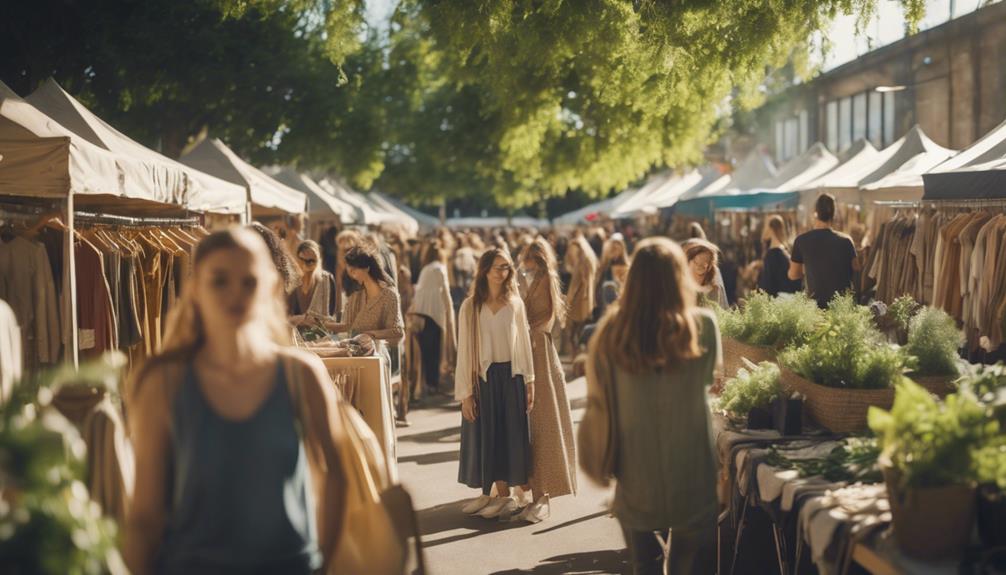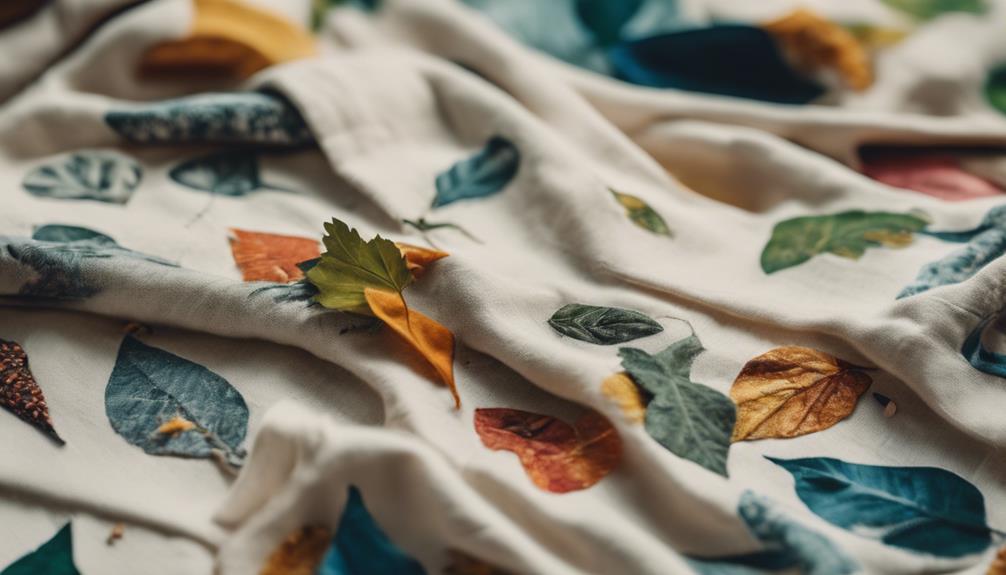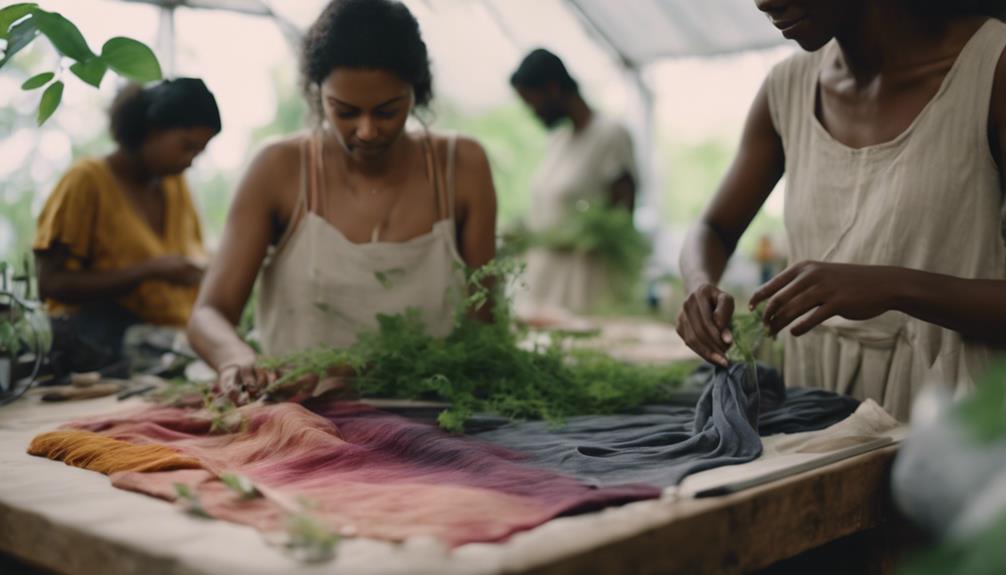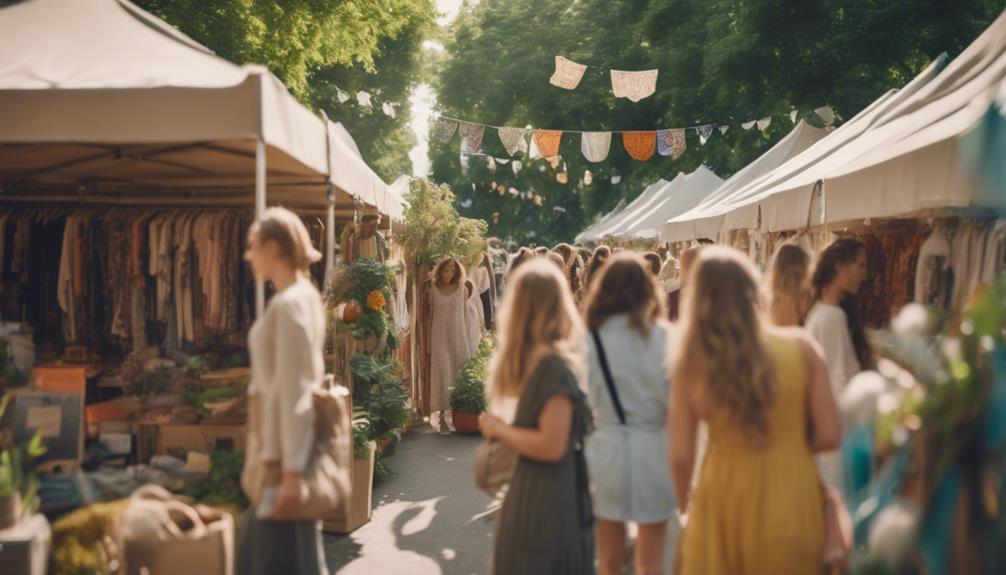Sustainable fashion is filled with vibrant and unique styles, featuring eye-catching colors and patterns that demonstrate a commitment to the planet. You can discover eclectic prints crafted from eco-friendly materials such as pineapple leather or natural dyes. This fashion emphasizes versatility and durability, offering clothing that is longer-lasting and reduces waste. Vintage pieces add a unique touch, while handmade items celebrate craftsmanship. In addition, children’s clothing is designed with durability and fun in mind, making sustainable fashion accessible to everyone. Interested in learning more about these amazing styles and how they can be incorporated into your wardrobe? The possibilities are truly endless!
Key Takeaways
- Sustainable fashion showcases vibrant, diverse styles made from eco-friendly materials, featuring bold colors and unique prints.
- Vintage and pre-worn clothing promote individuality while encouraging garment reuse, making each outfit special.
- Designers blend traditional craftsmanship with modern innovation, creating unique pieces from sustainable materials like pineapple leather and food waste fibers.
- Minimalist styles focus on versatility with muted colors and classic essentials, reducing the need for fast fashion.
Understanding Sustainable Fashion
Sustainable fashion isn't just about trends; it's about making thoughtful choices that benefit both the planet and people. When you think about a sustainable fashion look, consider the importance of versatility and longevity. Instead of filling your closet with fast fashion items that wear out quickly, focus on timeless pieces that you can wear often. These garments not only reduce waste but also save you money in the long run.
Sustainable fashion embraces responsible production methods and ethical labor practices. This means that when you shop, you should look for brands that prioritize eco-friendly materials. Upcycled and handmade items are fantastic options, as they often come with unique stories and craftsmanship.
Mending and repairing your clothes also extends their lifespan, promoting a more sustainable approach to your wardrobe.
Moreover, the sustainable fashion movement encourages you to explore various styles beyond minimalism. You can incorporate vibrant colors and prints made with environmentally safe dyes, allowing your personality to shine while still being mindful.
The Appeal of Unique Styles

Embracing sustainable fashion opens the door to a world of unique styles that allow you to express your individuality while being environmentally conscious. Unlike traditional fashion, sustainable fashion looks vibrant, diverse, and innovative. You can explore bold colors and eclectic prints, all while supporting eco-friendly materials. Vintage and pre-worn clothing provide you with distinctive pieces that not only stand out but also reduce environmental impact by promoting garment reuse.
Organizations like 'I Was A Sari' demonstrate how sustainable fashion can celebrate cultural heritage. By repurposing pre-loved saris into chic accessories and beachwear, they prove that style and sustainability can go hand in hand. Additionally, upcycled fashion initiatives, like No Borders in Mumbai, showcase unique pieces that reflect your personal style without compromising ethical standards.
As consumer preferences shift, designers feel inspired to innovate, creating sustainable fashion looks that blend style with environmental responsibility. This movement empowers you to make fashion choices that resonate with your values, ensuring that your wardrobe not only looks good but feels good too. One exciting way to learn more about sustainable fashion is by attending a sustainable fashion week event. These events showcase the latest in eco-friendly fashion and provide a platform for designers and brands dedicated to ethical and sustainable practices. Additionally, participating in a sustainable fashion week event can help you connect with like-minded individuals and learn about the positive impact you can make through your fashion choices.
Sustainable Fashion for Children
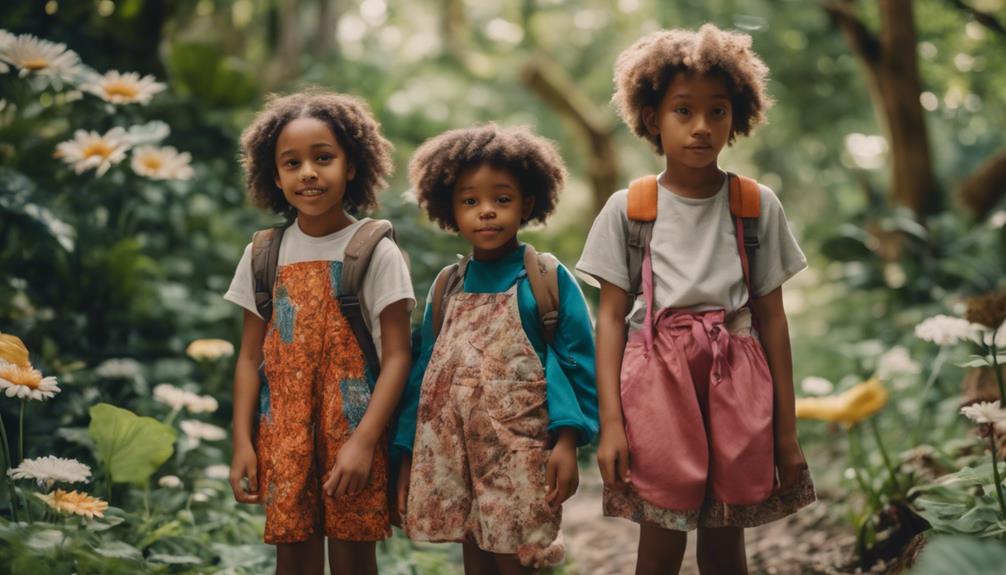
Choosing eco-friendly clothing for your kids not only promotes a healthier planet but also guarantees they've durable pieces that can withstand their active lifestyles.
Sustainable clothing is designed to last, reducing the need for constant replacements and helping you save money. Plus, you're nurturing a sense of responsibility in your children.
Here are three fantastic ways to embrace sustainable fashion for your little ones:
- Hand-Me-Downs: Encourage your kids to cherish and wear hand-me-downs. It teaches them the value of reusing and sharing.
- Secondhand Shopping: Explore thrift stores or platforms like eBay for affordable secondhand clothing bundles. You'll be surprised at the unique finds!
- Support Small Businesses: Look for local shops that prioritize eco-friendly practices. Buying from them not only supports your community but also promotes sustainable clothing production.
As you make these choices, you're not just dressing your children; you're instilling values that will last a lifetime.
Together, you can make a difference in reducing waste and promoting a more sustainable future for generations to come.
Footwear Innovations and Recycling
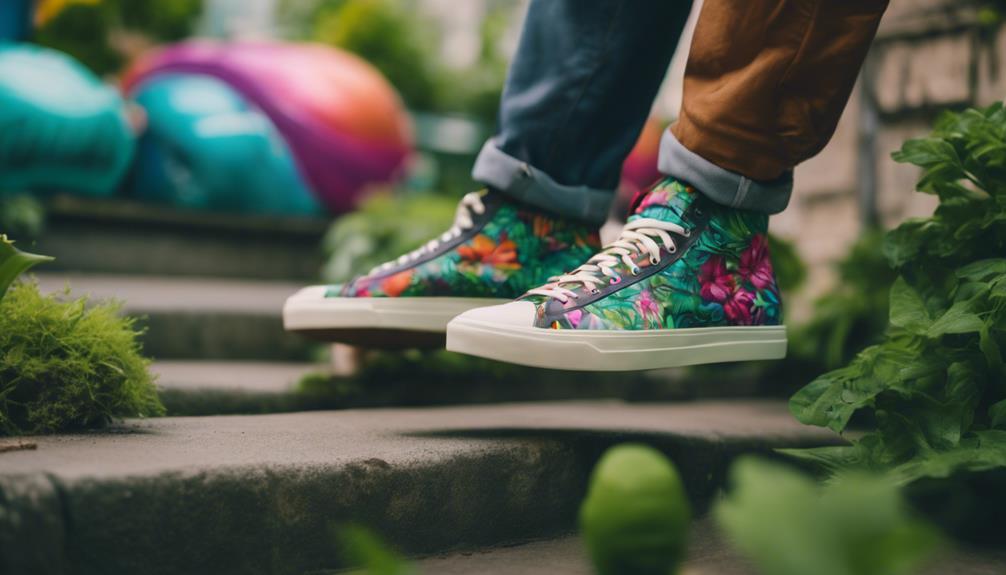
As you focus on eco-friendly clothing for your kids, don't overlook the importance of sustainable footwear innovations that are reshaping how we think about shoes. Brands like Clarks are leading the charge by offering recycling services in collaboration with Unicef, promoting a circular economy for shoes. This initiative not only helps reduce waste but also fosters a more sustainable future.
Many companies are now exploring the use of recycled materials to produce their footwear. By incorporating upcycled materials, such as old sneakers and plastic waste, these brands create unique designs while minimizing their environmental impact. You can feel good knowing that your kids' shoes might come from materials that would otherwise end up in landfills.
Moreover, donating shoes to charity shops is a simple way to keep footwear in circulation and support sustainability. This practice reduces waste and allows others to benefit from gently used shoes.
As awareness of sustainable footwear options grows, consumers like you are increasingly seeking brands that prioritize eco-friendly practices. By choosing sustainable footwear, you're not just making a fashion statement; you're contributing to a healthier planet for future generations.
Building Sustainable Shopping Habits
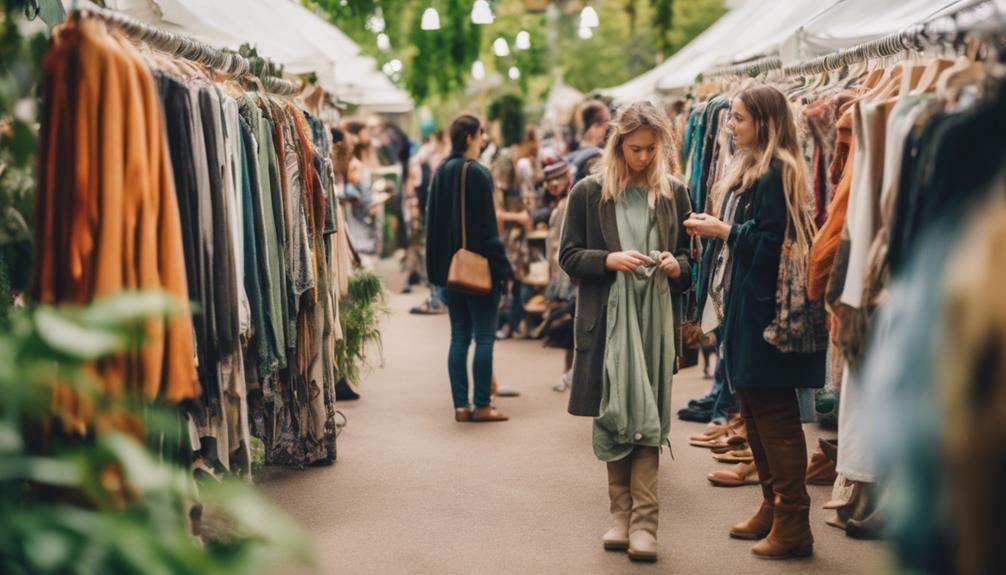
Building sustainable shopping habits starts with making intentional choices that prioritize quality over quantity in your wardrobe. By focusing on sustainable fashion, you not only enhance your style but also contribute positively to the environment.
Here are three key steps to help you build these habits:
- Invest in Versatile Pieces: Choose high-quality items that can be mixed and matched for different occasions. This not only reduces the need for constant shopping but also guarantees your wardrobe remains timeless.
- Explore Secondhand Options: Immerse yourself in thrift stores or online platforms like eBay. Not only does this reduce waste, but you also find unique pieces that tell their own story, which adds character to your style.
- Research Brands: Take the time to understand the sustainability claims of the brands you buy from. This knowledge empowers you to make informed choices and support those who genuinely uphold ethical practices.
Personal Style Exploration
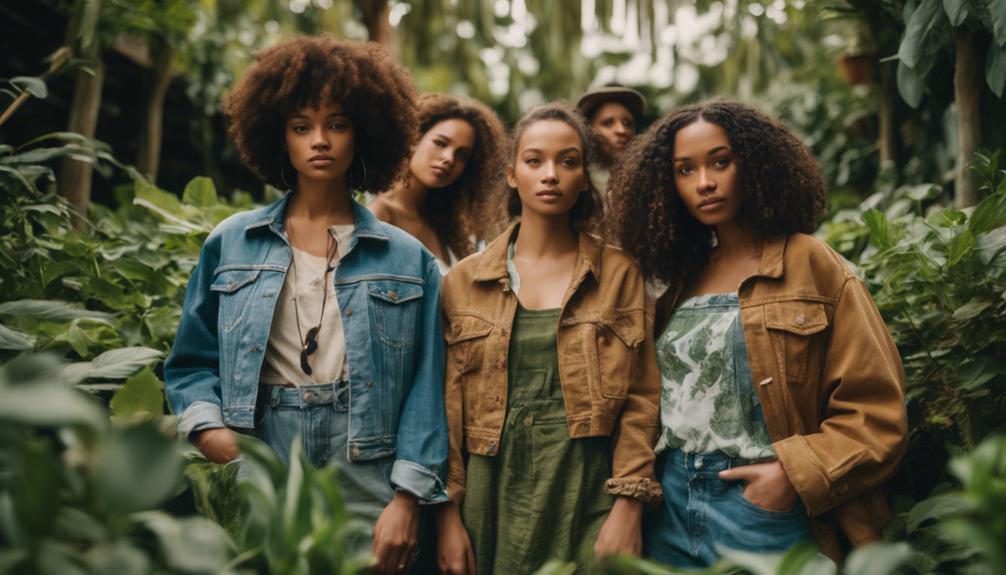
Exploring your personal style is essential for creating a sustainable wardrobe that truly reflects who you are. By defining your style through keywords like minimal, classic, and edgy, you can curate pieces that resonate with your preferences while embracing sustainable fashion principles.
A minimal style focuses on muted colors, structured silhouettes, and simple accessories. This approach promotes versatility and helps you resist fleeting trends.
On the other hand, classic essentials—think blazers, distressed denim, and high-quality knits—allow you to build a wardrobe that enhances comfort and confidence, steering clear of the disposable fashion cycle.
If you want to add a bit of flair, consider integrating edgy elements into your minimal or classic looks. Statement pieces can express your individuality without sacrificing sustainability.
Experimentation plays a significant role in discovering your unique style. Try different combinations and styles to see what resonates with you. The more you explore, the more you'll find outfit ideas that align with sustainable fashion.
Embrace this journey, and you'll end up with a wardrobe that not only looks good but also reflects your values.
The Impact of Material Choices

When you choose sustainable fashion, the materials you select play a vital role in your overall impact.
Natural fabrics offer comfort and biodegradability, while innovative waste materials are changing the game by reducing resource dependence.
Plus, opting for eco-friendly dyes not only protects the environment but also shapes the visual appeal of your wardrobe.
Natural Fabric Benefits
Have you ever considered how your choice of fabric impacts the environment? The materials you wear can greatly affect both the planet and the communities involved in their production.
Natural fabrics like cotton, silk, and wool offer numerous benefits that make them a sustainable choice. Here are three compelling reasons to embrace these materials:
- Biodegradable: Natural fabrics break down more easily than synthetics, reducing landfill waste and pollution.
- Support Local Artisans: Handwoven fabrics often rely on traditional techniques, empowering local artisans and preserving cultural heritage.
- Durability: Sustainable materials enhance the longevity of your garments, encouraging you to invest in quality clothing that aligns with your values.
Innovative Waste Materials
Natural fabrics pave the way for innovative waste materials that challenge conventional textile production and promote sustainability in fashion. You'll find exciting alternatives like pineapple leather and orange peel, which not only reduce waste but also create unique textures and aesthetics. These materials exemplify how sustainable fashion can thrive on creativity and resourcefulness.
By using fibers derived from food waste, such as bean fiber, brands help minimize environmental impact while supporting the circular economy. This approach encourages you to rethink waste as a resource rather than a problem.
Moreover, designers often turn to handwoven fabrics, celebrating traditional craftsmanship. While these pieces may have sizing limitations, they offer a personal touch that mass-produced items lack. Choosing sustainable fashion means valuing both quality and heritage.
As you explore these innovative options, remember that sustainable fashion isn't just about style; it's a commitment to eco-friendly principles. By embracing natural fabrics and innovative waste materials, you contribute to a more responsible fashion industry that prioritizes comfort, breathability, and environmental integrity. Your choices can help shape a future where fashion and sustainability go hand in hand.
Eco-Friendly Dye Options
Exploring eco-friendly dye options reveals how material choices greatly impact the sustainability of fashion. When you choose sustainable fashion, you're not just picking a style; you're making a statement about the environment.
Here are three reasons to contemplate eco-friendly dyes:
- Natural Vegetable Dyes: These dyes produce warm, earthy tones and minimize environmental risks. However, the color palette can be limited compared to synthetic options.
- Azo-Free Dyes: By avoiding harmful chemicals, these dyes reduce toxic waste in production, making your fashion choices safer for the planet and its people.
- Innovative Food Waste Dyes: Dyes made from orange peels and other food waste transform what would be discarded into vibrant color solutions, showcasing creativity and sustainability.
While sustainable fashion often prioritizes environmental considerations over flashy designs, embracing these eco-friendly dye options means you're contributing to a healthier planet.
Rethinking Fashion Industry Practices

You can see that the fashion industry needs to rethink its practices to truly embrace sustainability.
It's time to hold companies accountable for their production methods, demand transparency over greenwashing claims, and encourage collaborative efforts across the industry.
Accountability in Production Practices
Holding the fashion industry accountable for its production practices is essential to achieving true sustainability and minimizing environmental harm. You deserve to know that responsible fashion isn't just a buzzword; it's a commitment to making choices that genuinely protect the planet.
As you consider your clothing options, think about these key points:
- Over 60% of fashion products are made from non-biodegradable materials, creating long-lasting environmental damage.
- Many so-called eco-friendly innovations fail to reduce the fashion industry's overall negative impact on the environment.
- Without regulatory intervention, companies often escape accountability for their harmful practices.
The prevalent idea that sustainability exists on a spectrum can be misleading. Options labeled as 'less unsustainable' still contribute to the problem and don't reflect responsible production.
To foster real change, we need to shift our mindset from isolated innovations to systemic transformations that prioritize the planet and its communities. By holding brands accountable, you can support a fashion industry that values genuine sustainability and responsible practices.
Your choices can drive the demand for accountability, pushing for a future where fashion serves both style and the environment.
Transparency Over Greenwashing Claims
While many brands tout their sustainability credentials, the reality often reveals a troubling gap between marketing claims and genuine eco-friendly practices. Greenwashing has become rampant, confusing consumers who want to make sustainable choices. You must pay attention to what brands claim versus what they actually do.
| Common Claims | Reality Check |
|---|---|
| Carbon-positive products | Often lack substantial evidence |
| Organic and vegan materials | Frequently sourced from non-biodegradable components |
| Recycling initiatives | Rarely lead to significant environmental improvement |
To shift this narrative, regulatory interventions are becoming essential. Holding companies accountable for their sustainability claims can help guarantee transparency. True sustainability in fashion isn't just about isolated innovations; it requires a systemic change in industry practices.
As a conscious consumer, you have the power to demand more from brands and to educate yourself on the implications of your clothing choices. By prioritizing transparency over greenwashing claims, you can contribute to a fashion industry that genuinely values sustainability and accountability. It's time to rethink the practices that shape your wardrobe.
Collaborative Industry Change Efforts
Collaborative efforts among fashion brands, consumers, and policymakers are essential for rethinking industry practices and driving meaningful sustainability changes. The industry's shift toward sustainability hinges on shared responsibility and cooperation. By joining forces, we can tackle pressing challenges and create a more responsible fashion ecosystem.
Here are three powerful ways collaborative efforts can make a difference:
- Setting Ambitious Targets: Initiatives like the Fashion Pact unite over 60 global brands to commit to reducing greenhouse gas emissions and protecting biodiversity.
- Embracing Circular Economy: Brands are increasingly designing for longevity, repairability, and recyclability, ensuring that our fashion choices have a lasting positive impact.
- Promoting Transparency: Industry-wide initiatives like the Ethical Fashion Report empower consumers to make informed choices by rating brands on their environmental and social practices.
These collaborative efforts spark innovation and pave the way for a sustainable future. When you support brands that prioritize these initiatives, you're not just making a fashion statement; you're contributing to a movement that prioritizes our planet's health.
Together, we can reshape the fashion landscape for the better.
Frequently Asked Questions
What Does Sustainable Clothing Look Like?
Sustainable clothing often features natural fabrics, timeless designs, and earthy color palettes. You'll find versatile pieces that promote comfort and individuality, along with innovative materials that reflect a commitment to eco-friendly practices and reduce environmental impact.
What Do People Think About Sustainable Fashion?
You might think sustainable fashion's all about minimalism, but many crave unique styles. With rising skepticism over greenwashing, you're likely seeking transparency and personal expression, while recognizing vintage pieces' role in reducing environmental impact.
Why Is Sustainable Fashion Not Popular?
Sustainable fashion isn't popular because it often costs more, lacks awareness about ethical practices, and gets overshadowed by fast trends. Plus, many brands engage in greenwashing, leaving you confused about what's truly sustainable.
What Is Meant by Sustainable Fashion?
Ever wondered what sustainable fashion truly means? It's about making conscious choices that respect our planet and people. By prioritizing quality over quantity, you can help create a more ethical, environmentally friendly fashion industry.
Conclusion
In the vibrant tapestry of sustainable fashion, you're not just wearing clothes; you're making a statement.
By choosing eco-friendly styles, you're weaving together style and responsibility, showing the world that fashion can be both chic and conscious.
As you explore unique designs and innovative materials, remember that your choices echo far beyond your wardrobe.
So immerse yourself in this revolution and let your personal style shine while nurturing our planet.
After all, looking good shouldn't cost the Earth!


